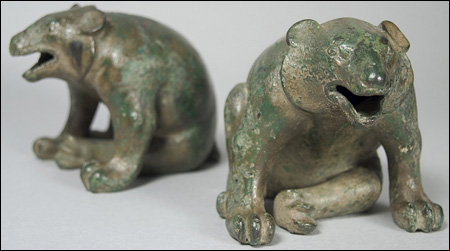‘A Bronze Menagerie’ at the Gardner, ‘Art & Science’ at AXIOM, and ‘Seeing Red’ and ‘Terrae Incognitae’ at Boston Sculptors

Isabella’s bears
|
The traditional way of being seated in ancient China, prior to the introduction of Western-style furniture, was on a floor mat, possibly anchored at its four corners by decorative weights. Your dinner mat, or in some cases your game board, might be secured by a quartet of small, whimsical bronze sculptures of real or imaginary animals — bears, felines, rams, winged beasts, turtles.
This everyday use for such objects has only recently been revealed by archæology. Frequently found buried with other luxury goods in aristocratic tombs, these figures, called “mat weights,” had been believed to delineate sacred spaces or to hold burial garments in place. An engaging pair of bronze bear mat weights were the first Chinese antiquities acquired by Isabella Stewart Gardner, who paid $30,000 for them in 1914. Dating from China’s Warring States Period and Han Dynasty (475 BC–AD 220), Mrs. Gardner’s beloved pair are joined by 40 additional bronze animals gathered from museums and private collections around the world in “A Bronze Menagerie: Mat Weights of Early China,” which opens at the Isabella Stewart Gardner Museum on October 5. The exhibition looks at the historic and ceremonial importance of these engaging objects, presents new evidence about their function and style, and explores animal symbolism and the structure of tombs in ancient China.
The Nature and Inquiry group of artists have been meeting weekly for 20 years to discuss topics ranging from gravity to senescence; their artwork is the subject of “Art and Science: A Symbiosis,” which is on view at Axiom Gallery. Artists Sarha Brady, Donald Burgy, John Holland, Margot Kelley, Nathalie Miebach, Amy Robinson, Nita Sturiale, Gail Wight, and Ron Wallace mine the places where artistic expression and the physical world meet — with results as varied as Wight’s presentation, through objects, electricity, text, and performance, of her thoughts on art and neurology and Kelley’s depiction of the ongoing battle between man and grass on the one side and on the other trees, which seem to be winning the battle in photographs taken near the artist’s home in Maine. On October 11, Axiom hosts a “Cultural Evolution Discussion” to explore ideas raised by the exhibition.
Common hardware, including metal pipes, hinges, and faucets, and soft fabric forms that are both evocative and abstract come together as sculpture in “Laura Evans: Seeing Red,” and the mysteries of lands unknown inspire new work in “Charles Jones: Terrae Incognitae.” Both exhibitions open at the Boston Sculptors Gallery on October 11.
ADVERTISEMENT
 |
“A Bronze Menagerie: Mat Weights of Early China” at Isabella Stewart Gardner Museum, 280 the Fenway, Boston | October 5–January 14 | 617.566.1401 | Art and Science: A Symbiosis”: “Cultural Evolution Discussion” at Axiom Gallery, 186 Hampshire St, Cambridge | October 11 at 7:30 pm | 617.513.6375 | “Laura Evans: Seeing Red” and “Charles Jones: Terrae Incognitae” at Boston Sculptors Gallery, 486 Harrison Ave, Boston | October 11–November 11 | 617.482.7781
On the Web
Isabella Stewart Gardner Museum: //www.gardnermuseum.org
Boston Sculptors Gallery: //www.bostonsculptors.com
Axiom Gallery: //www.axiomart.org